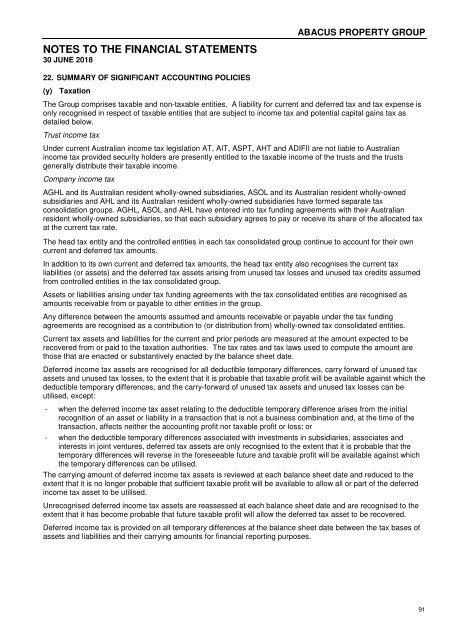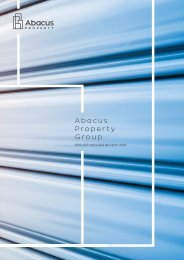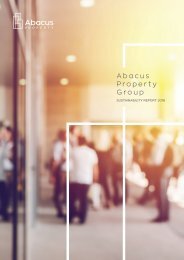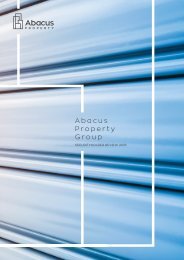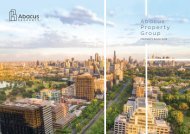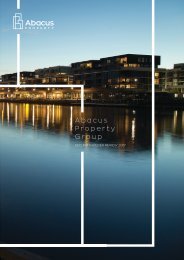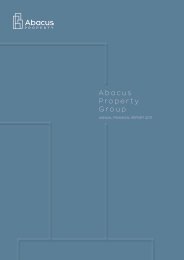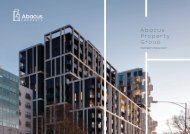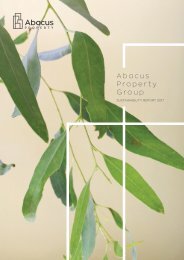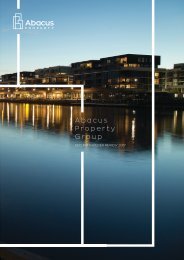Abacus Property Group – Annual Financial Report 2018
Create successful ePaper yourself
Turn your PDF publications into a flip-book with our unique Google optimized e-Paper software.
NOTES TO THE FINANCIAL STATEMENTS<br />
30 JUNE <strong>2018</strong><br />
ABACUS PROPERTY GROUP<br />
22. SUMMARY OF SIGNIFICANT ACCOUNTING POLICIES<br />
(l)<br />
Interest in joint arrangements<br />
The <strong>Group</strong>’s interest in joint venture entities is accounted for under the equity method of accounting in the<br />
consolidated financial statements. The investment in the joint venture entities is carried in the consolidated<br />
balance sheet at cost plus post-acquisition changes in the <strong>Group</strong>’s share of net assets of the joint ventures, less<br />
any impairment in value. The consolidated income statement reflects the <strong>Group</strong>’s share of the results of<br />
operations of the joint ventures.<br />
Investments in joint ventures are held at the lower of cost or recoverable amount in the investing entities.<br />
The <strong>Group</strong>’s interest in joint operations that give the parties a right to the underlying assets and obligations<br />
themselves is accounted for by recognising the <strong>Group</strong>’s share of those assets and obligations.<br />
(m) <strong>Property</strong>, plant and equipment<br />
Hotel property, plant and equipment<br />
<strong>Property</strong> (including land and buildings), plant and equipment represent owner-occupied properties and are initially<br />
measured at cost including transaction costs and acquisition costs. Subsequent to initial recognition, properties<br />
are measured at fair value less accumulated depreciation and any impairment in value after the date of<br />
revaluation.<br />
Depreciation is calculated on a straight-line basis over the estimated useful life of the asset as follows:<br />
Buildings <strong>–</strong> 50 years<br />
Revaluations of land and buildings<br />
Plant and equipment <strong>–</strong> 3 to 20 years<br />
Any revaluation increment is credited to the asset revaluation reserve included in the equity section of the balance<br />
sheet except to the extent that it reverses a revaluation decrease of the same asset previously recognised in<br />
profit or loss, in which case the increase is recognised in profit or loss.<br />
Any revaluation decrease is recognised in profit or loss except to the extent that it offsets a previous revaluation<br />
increase for the same asset in which case the decrease is debited directly to the asset revaluation reserve to the<br />
extent of the credit balance existing in the revaluation reserve for that asset.<br />
Gains and losses on disposals are determined by comparing proceeds with the carrying amount. These are<br />
included in the income statement.<br />
Any accumulated depreciation as at the revaluation date is eliminated against the gross carrying amounts of the<br />
assets and the net amounts are restated to the revalued amounts of the assets.<br />
Hotel property, plant and equipment are independently valued on an annual basis unless the underlying financing<br />
requires a more frequent independent valuation cycle.<br />
Other property, plant and equipment<br />
Land and buildings are measured at fair value, based on periodic valuations by external independent valuers, less<br />
accumulated depreciation on buildings and less any impairment losses recognised after the date of the<br />
revaluation.<br />
Plant and equipment is stated at historical cost less accumulated depreciation and any impairment losses.<br />
Depreciation is calculated on a straight-line basis over the estimated useful life of the asset as follows:<br />
Buildings <strong>–</strong> 40 years<br />
Plant and equipment <strong>–</strong> over 5 to 15 years<br />
86


